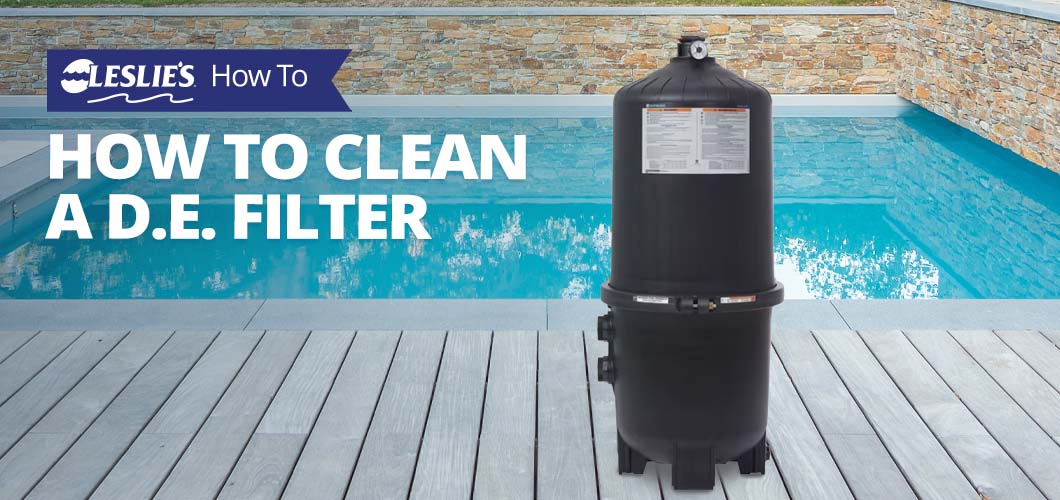
How To Clean a D.E. Filter
Keeping your pool in pristine condition requires regular maintenance, and one of the most important maintenance tasks is cleaning your D.E. (Diatomaceous Earth) pool filter. A clean D.E. filter ensures optimal filtration, keeping your pool water clear and free of debris, algae, and other contaminants.
So how do you properly clean a D.E. filter? Let’s walk through each step so you can maintain a healthy and clean pool all season long.
Understanding Your D.E. Filter
First, it's important to understand what each part of your D.E. filter does:
- Pressure Gauge: This is one of the most essential components of any pool filter, as it tells you when it's time to clean your filter. When the gauge reads 8–10 pounds per square inch (psi) over the normal starting pressure, your filter needs to be cleaned.
- Air Relief Valve: This valve is used to release air and water from the filter tank.
- Filter Grids: These grids hold the D.E. and act as a screen to capture dirt, debris, and other particles. The number, shape, and style of grids vary by manufacturer.
- Manifold: This collects the water after it passes through the grids, sitting directly atop the grids and holding them together in the filter.
You should clean your D.E. filter at least once a month, or whenever the pressure gauge is 8–10 psi above the normal starting pressure. Cleaning involves three basic steps: backwashing, cleaning the manifold and grids, and adding new D.E.
Needed Materials to Clean a D.E. Filter
- Garden hose with spray nozzle
- A large bucket
- Safety goggles and gloves
- Fresh D.E. powder or cellulose fiber
Once you have the necessary supplies, it's time to start cleaning your D.E. filter.
Step 1: Backwashing
Backwashing clears out the dirt and debris inside your D.E. filter. Follow these steps to properly backwash your filter:
- Position the Valve: Place the filter valve in the backwash position.
- Start the Pump: Turn on your pool pump. When the water coming out of the discharge hose is clear, shut off the pump and return the valve to its normal position.
- Drain the Filter: With the pump off, open the air relief valve and remove the drain plug to let the water out of the filter tank.
Step 2: Cleaning the Manifold and Grids
- Open the Filter Tank: Release the clamp around the tank or undo the bolts, depending on your D.E. filter model.
- Remove and Clean the Grids: Take out the manifold and each grid. Use a garden hose to flush out all the D.E. from the filter grids, then rinse the rest of the tank.
- Reassemble: Place the cleaned grids back in the manifold inside the filter. Lubricate the ring on the inside of the tank.
Step 3: Adding New D.E.
- Prime the Pump: Remove the strainer basket lid and fill the basket with water, letting some water run through the incoming line. Lubricate the O-ring or gasket in the pump lid, replace the lid, and tighten any clamps or bolts.
- Release Air: Turn the air relief valve to release excess air from the tank, then turn on the pool pump. Close the air relief valve when water begins to come out.
- Add D.E.: Calculate the amount of D.E. needed by dividing the square footage of your filter, either 24, 36, 48, or 60, by 5. Mix the D.E. with enough water to create a thin, creamy mixture. With the pump running, pour the mixture directly into the pool skimmer. After adding, let the pump run for at least 30 minutes to ensure the fresh D.E. circulates into the filter.
Step 4: Monitor the Filter Pressure
Keep an eye on the filter's pressure gauge for a few days after cleaning your D.E. filter. If the pressure rises significantly over the next few days, it may indicate that the filter needs another cleaning or that there is an issue with the system.
D.E. Filter Maintenance Tips
- Clean your D.E. filter at least once every six months, or more often if your pool gets heavy use.
- Backwash the filter regularly to maintain its efficiency between cleanings.
- Always wear protective gloves and goggles when handling D.E. powder and cleaning solutions.
A clean D.E. filter ensures optimal filtration, keeping your pool water clear and free of debris, algae, and other contaminants. For more information on how to care for your pool filters and other equipment, check out our Resource Center, visit our YouTube channel, or stop by your local Leslie’s and speak with one of our experts!